Common menu bar links
Institutional links
Diseases & Conditions
Health & Safety
Research & Statistics
Agency Information
Search Box
Healthy settings for young people in Canada
Previous | Table of Contents | Next
Health Risk Behaviours in Context
The association between daily smoking and living with both parents is more pronounced for girls than boys. Only 4% of girls who live with both parents smoke on a daily basis, compared to 11% of girls in other living arrangements (Figure 4.31).
Parent trust and communication is significantly associated with daily smoking in girls, but not in boys (Figure 4.32). Girls with a low score on the parent trust and communication scale are 3 times as likely to smoke daily as girls with a high score on the scale.
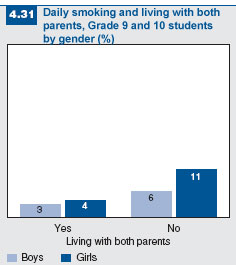
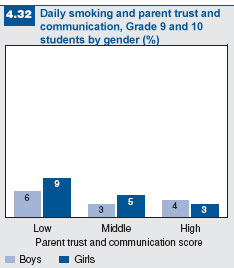
School-related variables are significantly associated with daily smoking. The relationship between academic achievement and daily smoking is more pronounced for girls than for boys, but with clear increases in percentage of students who smoke daily at each level of academic achievement in both genders (Figure 4.33).
While only 2% of boys and 3% of girls with a high score on the attitude towards school scale smoke daily (Figure 4.34), significantly more students (9% of boys and 11% of girls) with a low score on the same scale smoke daily.

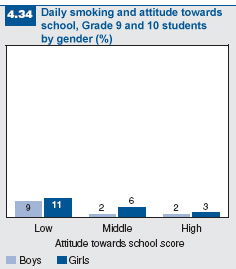
Communication within one’s peer group, which is a reflection of the degree of involvement with friends, does not seem to be important to daily smoking. This is apparent in Figure 4.35, which shows daily smoking to be on average the same for each level of the communication with friends scale.
Young people within a peer group usually share a common social world, a common language, and common behaviours. Students whose friends have a high score on the pro-social attitudes of friends scale are less likely to smoke daily (2% for both boys and girls), compared to 7% of boys and 12% of girls whose friends have a low score of the scale (Figure 4.36).


Family affluence is significantly associated with daily smoking for girls, but not for boys. Girls with low and moderate scores on the family affluence scale are twice as likely to smoke daily as girls with a high score on the scale (Figure 4.37).
The association between living with both parents and getting drunk at least twice indicates that students who live with both parents are less likely to drink excessively. A third of students who live with both parents report getting drunk at least twice, compared to about two-fifths of those who do not live with both parents (Figure 4.38).
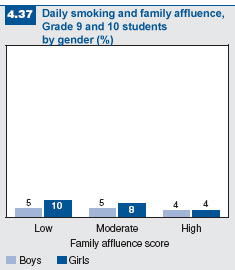

Students with a low score on the parent trust and communication scale are significantly more likely to report getting drunk more than twice (Figure 4.39). The influence is greater for girls. Among those with a low score on the parent trust and communication scale, 42% of girls report getting drunk at least twice, compared to 23% of those with a high score on the scale.
The association between academic achievement and getting drunk at least twice is quite strong, particularly for girls (Figure 4.40). For example, of those girls with marks of less than 50%, 63% report getting drunk at least twice, compared to 55% of girls with marks between 50 and 59%, and only 20% of girls with marks of 85% or higher.
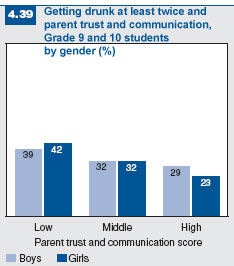
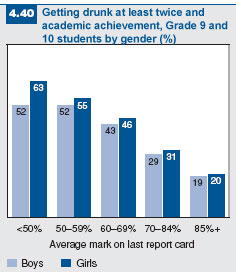

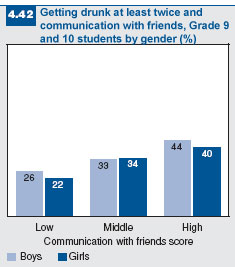
The extent to which school is perceived as providing a supportive environment for young people, based on their feelings of belonging and of school and teacher fairness, is significantly associated with getting drunk at least twice for both boys and girls. Figure 4.41 shows that 43% of boys and 46% of girls with a low score on the attitude towards school scale report getting drunk at least twice, compared to 23% of boys and 32% of girls with a high score on the scale.
Unlike its lack of influence on daily smoking (see Figure 4.35), better communication with one’s friends is significantly associated with binge drinking. This is apparent in Figure 4.42, showing that twofifths of students with a high score on the communication with friends scale report getting drunk at least twice, compared to, on average, a quarter of students with a low score on the scale. This implies that students with good communication skills are more likely to report getting drunk at least twice than their counterparts whose communication with friends is poorer.
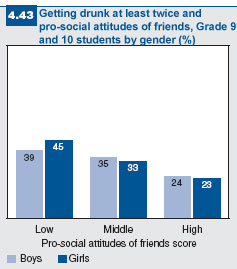 Similar
to daily smoking (see Figure 4.36),
students whose friends demonstrate high
levels of pro-social attitudes are less likely
to report getting drunk at least twice
(24% of boys and 23% of girls), compared
Similar
to daily smoking (see Figure 4.36),
students whose friends demonstrate high
levels of pro-social attitudes are less likely
to report getting drunk at least twice
(24% of boys and 23% of girls), compared to 39% of boys and 45% of girls whose
friends fall into the low third of the
pro-social attitudes of friends scale
(Figure 4.43).
to 39% of boys and 45% of girls whose
friends fall into the low third of the
pro-social attitudes of friends scale
(Figure 4.43).
Family affluence is not associated with getting drunk at least twice for either girls or boys, indicating that students engage in binge drinking behaviour regardless of whether they are affluent or not (Figure 4.44).
Students who live with both parents are less likely to use cannabis (15% of boys and 13% of girls), compared to one-quarter of those in other living arrangements (Figure 4.45).
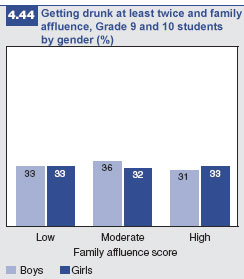
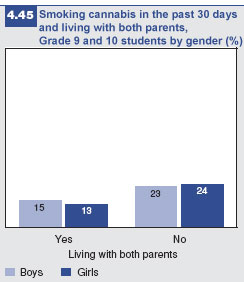
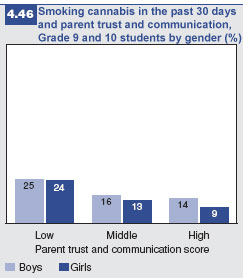
A poor relationship between students and their parents, as assessed by the parent trust and communication scale, is significantly associated with using cannabis in the past 30 days for both girls and boys (Figure 4.46).
